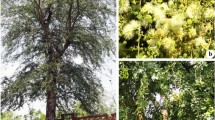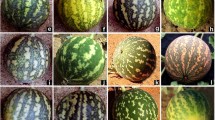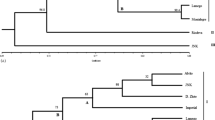Abstract
Collected from Chinese mainland, 25 samples of Toona sinensis seed were planted in a standard garden. Three years later, samples were analyzed with random amplified polymorphic DNA (RAPD) and isoenzymes variants of cytochrome oxidase and peroxidases. Results of RAPD and isoenzymes variants were analyzed with software POPGENE32 and SPSS10.0 respectively. Phylogenetic trees were calculated from the clustered result of RAPD and isoenzymes variants. Such additional factors as leaves color, latitude and altitude of original seeds were analyzed at the same time. Our result suggested that a general similarity is concurred with the three analyses as RAPD, isoenzymes variants analysis of peroxidases and cytochrome oxidase. Two clusters can be separated from the sample collected as southern and northern ones. In the evolutionary history, a migrating route in the direction from West-South to East-North and with sequential differentiation in the direction South-North can be decided if only it is true with the argument that Toona sinensis came from tropic Asia, the border of east-north India and Burma.
Similar content being viewed by others
Abbreviations
- RAPD:
-
random amplified polymorphic DNA
References
Baes P. & Van Cutsem P. 1993. Electrophoretic analysis of eleven isozyme systems and their possible use as biochemical markers in breeding chicory (Cychorium intybus L.). Plant Breeding 110: 16–23.
Boody G., Hendriks R.J.J., Smulders M.J.M., Van Groenendael J.M. & Vosman B. 2000. Genetic diversity and the survival of populations. Plant Biol. 2: 379–395.
Bussell J.D. 1999. The distribution of random amplified polymorphic DNA (RAPD) diversity amongst populations of isotoma petraea (Lobeliaceae). Mol. Ecol. 8: 775–789.
Chang H.C., Hung W.C., Huang M.S. & Hsu H.K. 2002. Extract from the leaves of Toona sinensis Roemor exerts potent antiproliferative effect on human lung cancer cells. Am. J. Chin. Med. 30: 307–314.
Chang H.L., Hsu H.K., Su J.H., Wang P.H., Chung Y.F., Chia Y.C., Tsai L.Y., Wu Y.C. & Yuan S.F. 2006. The fractionated Toona sinensis leaf extract induces apoptosis of human ovarian cancer cells and inhibits tumor growth in a murine xenograft model. Gynecol. Oncol. 102: 309–314.
Cho E.J., Yokozawa T., Rhyu D.Y., Kim H.Y., Shibahara N. & Park J.C. 2003. The inhibitory effects of 12 medicinal plants and their component compounds on lipid peroxidation. Am. J. Chin. Med. 31: 907–917.
Daniels J. & Roach B.T. 1987. Taxonomy and evolution, pp. 7–84. In: Heinz D.J. (ed.) Sugarcane Improvement through Breeding, Elsevier, Amsterdam.
Edmonds J.M. & Staniforth M. 1998. Toona sinensis: Meliaceae. Curtis’s Botanical Magazine 15: 186–193.
Guo Z.H. 1993. Cytology analysis with Toona sinensis — chromosome determination. Acta Horticulturae Sinica 20: 199–200.
Hamrick J.L. & Godt M.J.W. 1990. Allozyme diversity in plant species, pp. 43–63. In: Brown A.H.D., Clegg M.T., Kahler A.L. & Weir B.S. (eds) Plant Population Genetics, Breeding, and Genetic Resources. Sinauer Associates, Sunderland, MA.
Kang T.J. & Yang M.S. 2004. Rapid and reliable extraction of genomic DNA from various wild-type and transgenic plants. BMC Biotechnol. 4: 20.
Lu C.X., Zhang D.C. & Wang D.B. 2001. Origin and taxonomic position of Chinese toon [Toona sinesis (A. Juss.) Roem.]. Bulletin Bot. Res. 21: 195–199.
Luo X.D., Wu S.H., Ma Y.B. & Wu D.G. 2001. Studies on chemical constituents of Toona sinensis. Chinese Traditional and Herbal Drugs 32: 390–391.
Lynch M. & Milligan B.G. 1994. Analysis of population genetic structure with RAPD markers. Mol. Ecol. 3: 91–99.
Martin C., Gonzalez-Benito M.E. & Iriondo J.M. 1997. Genetic diversity within and among populations of a threatened species: Erodium paularense Fern. Gonz. Izco. Mol. Ecol. 6: 813–820.
Nei. 1972. Nei’s original measures of genetic identity and genetic distance. Am. Nat. 106: 283–292.
Park J.C., Young H.S., Yu Y.B. & Lee J.H. 1993. Studies on the chemical components and biological activities of edible plants in Korea. (I) Phenolic compounds from the leaves of Cedrela sinensis A. Juss. Yakhak Hoechi 37: 306–310.
Park J.C., Yu Y.B., Lee J.H. & Kim N.J. 1994. Anti-inflammatory and analgesic effect of the components from some edible plants. J. Korean Soc. Food Nutr. 23: 671–674.
Sneath P.H.A. & Sokal R.R. 1973. Numerical Taxonomy. Freeman & Co., San Francisco.
Tsai I.L., Jeng Y.F., Duh C.Y. & Chen I.S. 2001. Cytotoxic constituents from the leaves of Litsea akoensis. Chinese Pharm. J. 53: 291–301.
Wang K.J., Yang C.R. & Zhang Y.J. 2007. Phenolic antioxidants from Chinese toon (fresh young leaves and shoots of Toona sinensis). Food Chem. 101: 365–371.
Wang W.Y, Geng C.H., Zhang Y.L., Shi X. & Ye J.N. 2007. CE-ED separation and determination of seasonal content variantss of some active ingredients in Toona sinensis (A. Juss.) Roem leaves. Chromatographia 66: 697–701.
Williams J.G.K., Kubilek A.R., Livak K.J., Rafalski A.J. & Tingey S.V. 1990. DNA polymorphism amplified by arbitrary primers are useful as genetic markers. Nucleic Acids Res. 18: 6531–6535.
Wolfe A.D. & Liston A. 1998. Contributions of PCR-based methods to plant systematics and evolutionary biology, pp. 45–55. In: Soltis D.E., Soltis P.S. & Doyle J.J. (eds) Molecular Systematics of Plants II. Kluwer Academic Publishers, Boston, Dordrecht, London.
Wu Z.M. 1984. Auspicious tree — chromosome determination of Toona sinensis. Anhui Forestry Science and Technology 3: 21–25.
Author information
Authors and Affiliations
Corresponding author
Rights and permissions
About this article
Cite this article
Wang, C., Cao, J., Tian, S. et al. Germplasm resources research of Toona sinensis with RAPD and isoenzyme analysis. Biologia 63, 320–326 (2008). https://doi.org/10.2478/s11756-008-0066-3
Received:
Accepted:
Published:
Issue Date:
DOI: https://doi.org/10.2478/s11756-008-0066-3




